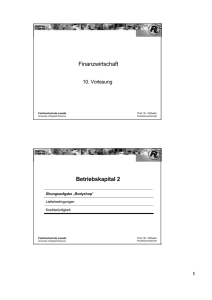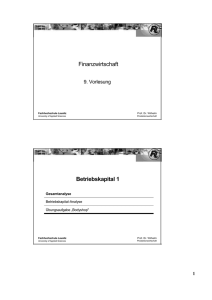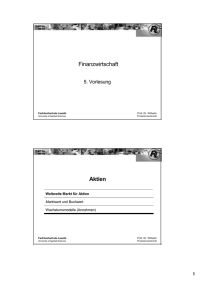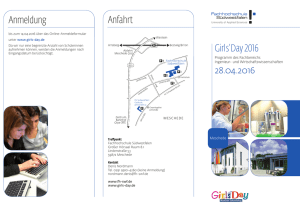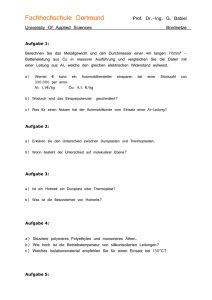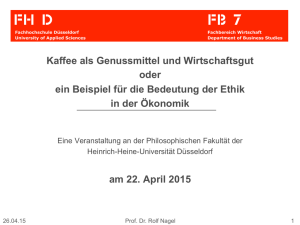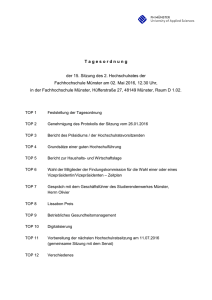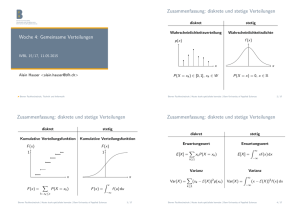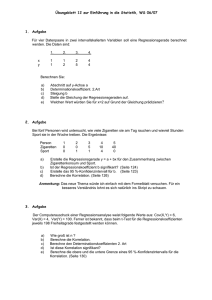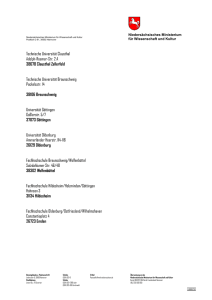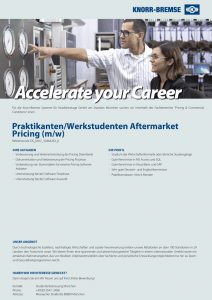13_FW_Kapitalmarkt_3
Werbung
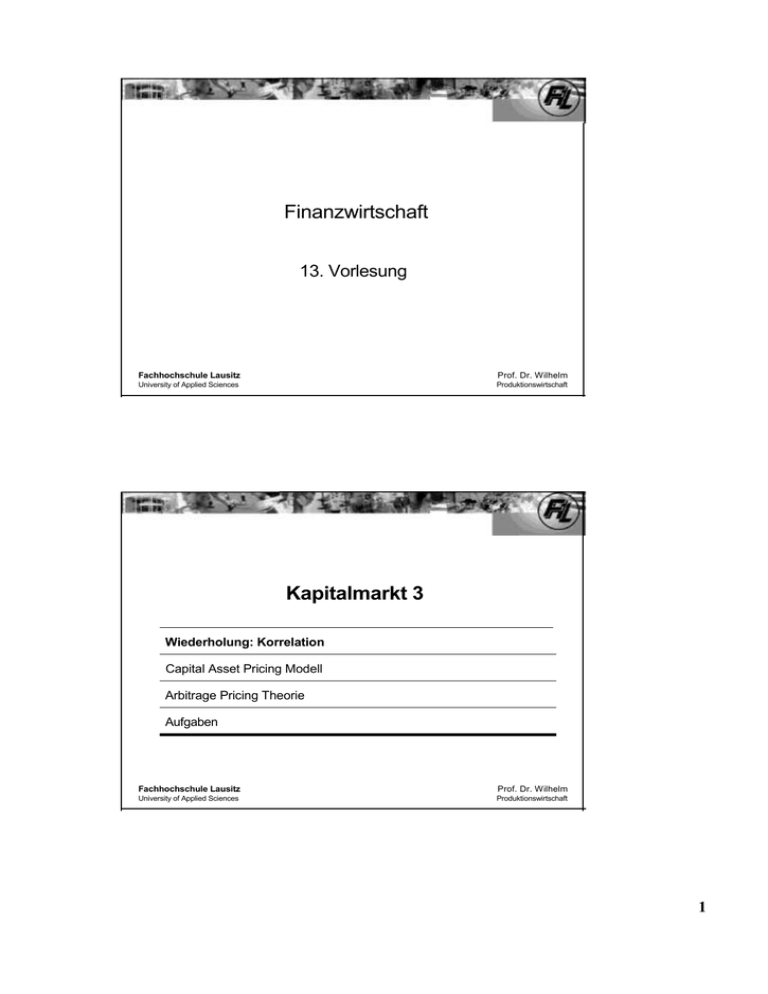
Finanzwirtschaft 13. Vorlesung Fachhochschule Lausitz Prof. Dr. Wilhelm University of Applied Sciences Produktionswirtschaft Kapitalmarkt 3 Wiederholung: Korrelation Capital Asset Pricing Modell Arbitrage Pricing Theorie Aufgaben Fachhochschule Lausitz Prof. Dr. Wilhelm University of Applied Sciences Produktionswirtschaft 1 Korrelation: Metrische Gemeinsamkeitskalkulation Fachhochschule Lausitz Prof. Dr. Wilhelm University of Applied Sciences Produktionswirtschaft Mehrdimensionale Merkmale: Korrelation und Regression Analyse von Zusammenhängen stehen sehr oft im Mittelpunkt von Datenanalysen, z.B. die Frage nach dem Zusammenhang zwischen • Geschlecht und Medienkonsum • Alter und Fernsehdauer • Art der Zeitung und Arbeitsalltag der Redakteure • Medikation (Dosis) und Lebensdauer (Wirkung) Wir benötigen dazu die simultane Darstellung und Beschreibung von mehreren Merkmalen Fachhochschule Lausitz Prof. Dr. Wilhelm University of Applied Sciences Produktionswirtschaft 2 2 Darstellung des Zusammenhangs von zwei metrischen Merkmalen • Daten liegen zu zwei metrischen Merkmalen vor: Datenpaare (xi yi), I=1,..n • Bespiel : x: Anzahl der fest angestellten Mitarbeiter, • y : Anzahl der freien Mitarbeiter • Frage: Gibt es einen Zusammenhang zwischen diesen Merkmalen ? Wie lässt sich dieser Zusammenhang beschreiben? • Einfachste graphische Darstellung: Streudiagramm. • Die Datenpaare entsprechen Punkten in der Ebene („Punktwolke") Fachhochschule Lausitz Prof. Dr. Wilhelm University of Applied Sciences Produktionswirtschaft Streudiagramm mit Excel Fachhochschule Lausitz Prof. Dr. Wilhelm University of Applied Sciences Produktionswirtschaft 3 3 Bespiel 1: Streudiagramm (mit SPSS) 60 0 o 50 0 o 40 0 CD o O 30 0 o 20 0 3) o or QD O 10 0 o o o o o o o ID o o o o8o o o 0 0 200 0 ctpW *><? o 100 Festangestellte Mitarbeiter Fachhochschule Lausitz Prof. Dr. Wilhelm University of Applied Sciences Produktionswirtschaft Beispiel 2: Streudiagramm (mit SPSS) 0 200000 400000 600000 800000 1000000 1200000 Durchschnittliche Auflage der Zeitung 2002 von Montag bis Freitag Fachhochschule Lausitz Prof. Dr. Wilhelm University of Applied Sciences Produktionswirtschaft 4 Kovarianz Ein Maß für den Zusammenhang der beiden Merkmale Daten: 1 s XY " = ' Beachte: • Summand i positiv , falls xi und yi relativ zum Mittelwert das gleiche Vorzeichen haben • Für Sxx ergibt sich die Varianz von x • Die Kovarianz hängt sowohl von der Streuung als auch von dem Zusammenhang der beiden Merkmale ab Fachhochschule Lausitz Prof. Dr. Wilhelm University of Applied Sciences Produktionswirtschaft Bravais-Pearson-Korrelationskoeffizient Der Bravais-Pearson-Korrelationskoeffizient ergibt sich aus den Daten ( x i , y i ) , i = ,■ ■ ■ ,n, durch r=SxSy ==11 (=1 Wertebereich: r>0 positive Korrelation,gleichsinniger linearer (xi,yi)Zusammenhang, Tendenz: Werte r<0 um eine Gerade positiver Steigung liegend negative Korrelation, gegensinniger linearer Z(xi,yi)usammenhang, Tendenz: Werte Fachhochschule Lausit um eine Gerade negativer Steigung liegend ........................ _, , Prof. Dr. Wilhelm , unkorreliert, kein linearer ZusammenhangProduktionswirtschaft 5 5 Beispiele für Korrelation Fachhochschule Lausitz Prof. Dr. Wilhelm University of Applied Sciences Produktionswirtschaft Eigenschaften des Korrelationskoeffizienten • Maß für den linearen Zusammenhang • Ändert sich nicht bei linearen Transformationen • Symmetrisch (Korrelation zwischen x und y = Korrelation zwischen y und x) • Positive Korrelation bedeutet: Je größer x desto größer im Durchschnitt y • Korrelation = +1 oder -1 falls die Punkte genau auf einer Geraden liegen • Korrelation = 0 bedeutet keinen linearen Zusammenhang, aber nicht notwendig Unabhängigkeit • Korrelation empfindlich gegenüber Ausreißern Fachhochschule Lausitz Prof. Dr. Wilhelm University of Applied Sciences Produktionswirtschaft 6 6 Beispiel 1: Korrelation (mit SPSS) 600 500 Korrelationen Festangestellt e Mitarbeiter 400 o o Freie Mitarbeiter 1 Festangestellte Korrelation nach Pearson Mitarbeiter Signifikanz (2-seitig) Quadratsum men und Kreuzprodukte Kovarianz N ,510 ,000 273002,486 286393,695 3739,760 74 4937,822 59 aas o Freie Mitarbeiter ,510 ,000 1 286393,695 1580574,3 4937,822 59 27251,281 Korrelation nach Pearson Signifikanz (2-seitig) Quadra tsum men und Kreuzprodukte Kovarianz N 200 59 o 100 oo o o °o@o o °o 0 0 0 0 100 300 200 Festangestellte Mitarbeiter Prof. Dr. Wilhelm Fachhochschule Lausitz University of Applied Sciences Produktionswirtschaft Beispiel 2 Korrelation (mit SPSS) Korrelationen Durchschnittl iche Auflage 2002 von Montag bis Festangestellt e Mitarbeiter 300 M i tangestellte arb eiter K ° sI orrel at gnifi ka euz pr duktT" U"d K U u d e M o 200 1* chschnittliche A tag bis Freitag flag e K K 273002,486 ,622 ,000 490908354 3739,760 74 7114613, 830 70 z (2-seitig) orrel at gnifi ka uadr at euz pr ,622 z (2-seitig) 490908354,3 6,768E+1 2 7114613, 830 9,669E+10 70 71 Ohne die beiden Extrempunkte: i 100 » Festangestellt 00 Dur Mitarbeiter Ko »(Ä) 5 nz (2-seitig) 3286,675 c 3 schnittl Auflage eitung ag bis itag 66,330 5 525 Mo 6 0 200000 400000 600000 800000 1000000 1200000 Durchschnittliche Auflage der Zeitung 2002 von Montag bis Freitag Fachhochsc hule Lausitz University of Applied Sciences der Zeitung 2002 von Montag bis Freitag Kr nifi ka ,750 nz (2-seitig) dukte 35221 0044,1 5256866,330 n H Z Prof. Dr. Wilhelm Produktionswirtschaft 7 7 Kapitalmarkt 3 Wiederholung: Korrelation Capital Asset Pricing Modell Arbitrage Pricing Theorie Aufgaben Fachhochschule Lausitz Prof. Dr. Wilhelm University of Applied Sciences Produktionswirtschaft Capital Asset Pricing Model (CAPM) • The expected risk premium on an investment varies in direct proportion to beta => all investments must plot along the sloping line know as security market line (SML) • Market risk premium = (rm - rf) • rf = risk free rate • rm = return on the market portfolio Fachhochschule Lausitz Prof. Dr. Wilhelm University of Applied Sciences Produktionswirtschaft 8 CAPM (Cont'd) • ri = rf + Bi( r m -rf) Expected return SML Expected market return Risk free rate Beta 0 Fachhochschule Lausitz Prof. Dr. Wilhelm University of Applied Sciences Produktionswirtschaft How to obtain Beta? • Using market model: Expected stock Slope=Beta return Expected market return Beta is the slope of the regression line. Fachhochschule Lausitz Prof. Dr. Wilhelm University of Applied Sciences Produktionswirtschaft 9 9 How to obtain Beta? (Cont'd) • Beta can also be obtained from the correlation coefficient and the standard deviation: *m • ßA = Beta of stock A • pAm = Correlation between stock A and the market portfolio • OA = Standard deviation of stock A • Om = Standard deviation of the market portfolio Fachhochschule Lausitz Prof. Dr. Wilhelm University of Applied Sciences Produktionswirtschaft Is Beta Dead? • Empirical evidence is inconsistent with CAPM • Alternative measures suggested: • price-to-earnings (P/E) ratio • market-to-book (M/B) value ratio Fachhochschule Lausitz Prof. Dr. Wilhelm University of Applied Sciences Produktionswirtschaft 10 Kapitalmarkt 3 Wiederholung: Korrelation Capital Asset Pricing Modell Arbitrage Pricing Theorie Aufgaben Fachhochschule Lausitz Prof. Dr. Wilhelm University of Applied Sciences Produktionswirtschaft Arbitrage Pricing Theory (APT) • Returns on securities are generated by industry wide and market-wide factors such as • interest rates • gross national product (GNP) • economic conditions • Two securities are correlated if they are affected by the same factors. Fachhochschule Lausitz Prof. Dr. Wilhelm University of Applied Sciences Produktionswirtschaft 11 Comparing APT & CAPM • Similarities: • they are both risk-based models, implying positive relationship between expected return and risk • In a one-factor APT model, the systematic risk is simply the beta of CAPM • Differences: • CAPM is a one-factor model and APT could be multifactors Fachhochschule Lausitz Prof. Dr. Wilhelm University of Applied Sciences Produktionswirtschaft Comparing APT & CAPM (Cont'd) • Differences (Cont’d): • APT model adds factors until the unsystematic risk diminish and systematic risks do not decrease. • CAPM assumes all the common factors affecting returns are lumped into the market portfolio return Fachhochschule Lausitz University of Applied Sciences 12 Kapitalmarkt 3 Wiederholung: Korrelation Capital Asset Pricing Modell Arbitrage Pricing Theorie Aufgaben Fachhochschule Lausitz Prof. Dr. Wilhelm University of Applied Sciences Produktionswirtschaft Question 1 • Scientific Investment Fund has a total investment of $2 million and consists of the following stocks. • Stock Investment Beta • A $ 200,000 1.50 • B 300,000 0.50 • C 500,000 1.25 • D 1,000,000 0.75 • The required rate of return for the market portfolio is 15% and the risk-free rate is 7 %. • What is the required rate of return for this Fund? Fachhochschule Lausitz Prof. Dr. Wilhelm University of Applied Sciences Produktionswirtschaft 13 Question 2 • A share of stock with a beta of 1.2 now sells for $50. • Investors expect the stock to pay a year-end dividend of $3. • The T-bill rate is 4%, and the market risk premium is perceived to be 8%. • What is the investors' expectation of the price of the stock at the end of the year? Fachhochschule Lausitz Prof. Dr. Wilhelm University of Applied Sciences Produktionswirtschaft Question 3 • Oakdale Furniture, Inc. has a beta coefficient of 0.7 and a required rate of return of 15%. • The market risk premium is currently 5%. • If we expect inflation to cause a 2 percentage points increase in risk free rate and Oakdale were to acquire assets which will increase its beta by 50 percent, what will be Oakdale's new required rate of return? Fachhochschule Lausitz Prof. Dr. Wilhelm University of Applied Sciences Produktionswirtschaft 14 Question 4 • Angel Enterprise hires you to figure out whether the 12% required rate of return is appropriate for the company. You collected the following information: • Correlation coefficient of Angel and the market = 0.25 • Standard deviation of Angel's returns = 0.2 • Standard deviation of the market portfolio = 0.1 • T-bill rate = 6% • Return on the market portfolio = 15% • What is your advice? Fachhochschule Lausitz Prof. Dr. Wilhelm University of Applied Sciences Produktionswirtschaft Question 5 • The market price of a security is $40. Its expected rate of return is 13%. The risk-free rate is 7% and the market risk premium is 8%. • Assume that the stock is expected to pay a constant dividend in perpetuity and all other variables remain unchanged. • What will be the market price of the security if its covariance with the market portfolio doubles? Fachhochschule Lausitz Prof. Dr. Wilhelm University of Applied Sciences Produktionswirtschaft 15
